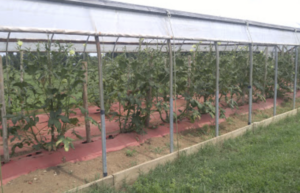
Some farmers call them “tall tunnels.” Others call them “hoop houses.” The name may vary but I have been using high tunnels since the 1990s.
Covered tunnels enable me to extend the growing season on the front end and the back end by four to six weeks. Tall tunnels first caught my eye because they are very inexpensive compared to a greenhouse. However, they do require a lot of labor and management.
Regulating temperature in tall tunnels
To cool a tall tunnel, you raise the sides and open the ends. Coversely, to warm the structure, you do the opposite. A tall tunnel is not heated or cooled from within like a greenhouse is. Therefore, you cannot grow summer crops in the dead of winter. But you can grow greens and spinach.
In the past, no one has recommended that home gardeners use tall tunnels. I believe that full-time dedicated home gardeners could get a cheap thrill from growing crops in a tall tunnel. Especially since the main investment would be your time. It’s thrilling to watch tomatoes take on a tropical-like growth.
My tall tunnels are 17 feet by 96 feet. Many other farmers’ tall tunnels are much larger. It’s easier to ventilate a narrower structure than a wider one. The only thing I would change on mine would be to make them a foot and a half taller to allow for even more ventilation. You can build your own or order them pre-buiolt and put them up yourself as I did.
Tall tunnels come in 4-foot sections. I would recommend starting with a 17- by 20-foot structure, give or take, depending on your level of commitment. It’s better to start off too small than too big. All it really takes is a backyard and a strong desire. That’s the beauty of gardening. The exercise and better-than-summertime-tasting tomatoes are just the icing on the cake.
Because you control the weather within a tall tunnel, it can be more conducive to organic farming. The plants are watered with a trickle tube in the row, instead of being watered overhead by either rain, wily-nily or irrigation. Rain and nightly dews that promote disease in tomato plants, along with rot and splits in the fruit, are avoided.
Tall tunnel crops still need insects
It’s easier to keep beneficial insects (including bees) inside a tall tunnel and the undesirable insects out. The water spigot on the outside of your house should be sufficient to supply a small tall tunnel with water.
Bumblebees for tall tunnels can be purchased. These bees are not aggressive unless you kick their hive. On days the tall tunnel is open the bees will pollinate all the flowers on your block as well as plants in the tunnel.
A tall tunnel has to be watched closely to be successful. If you go off and leave it, you will end up with fried green tomatoes. But the benefits of a tall tunnel far outweigh the investment in management over a regular outdoor garden.
Tall tunnel benefits
- Very inexpensive compared to a greenhouse.
- Backup heat for cold snaps can be used to extend the growing season even longer.
- A big space saver for small backyards.
- Protects the Chesapeake Bay from fertilizer and pesticide runoff.
- Makes organic farming relatively easier.
The next time you visit Snead’s Farm (we open after asparagus comes in in April), be sure to take a look at the tall tunnels we use to keep our tomatoes and other crops going for a larger part of the year.
Adapted from a column that first appeared in The Free Lance—Star on June 1, 2012.
